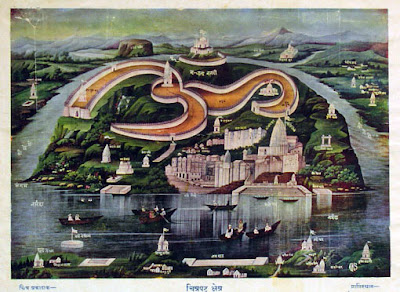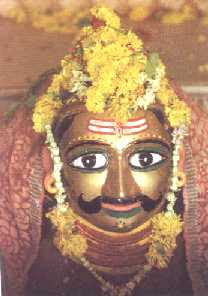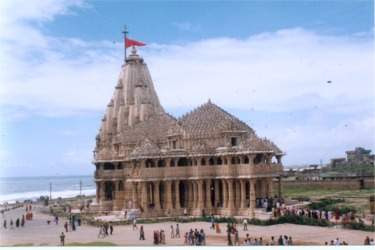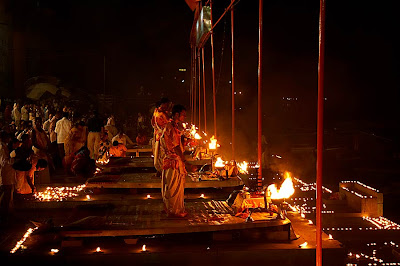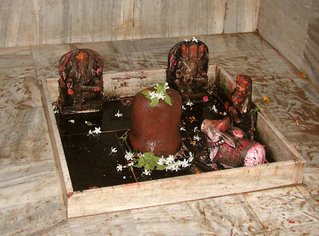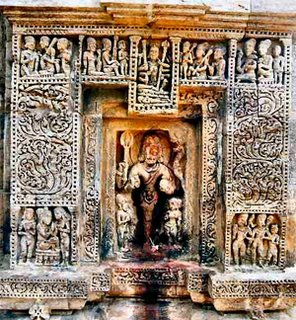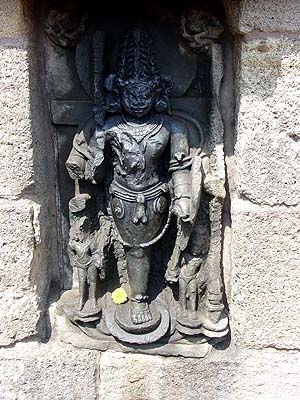
Click on the photo to enlarge it.
Trithalam trigunadhaaram trinetram chatriyayudham |
Trijanma-papasamharam Yega-vilvam Sivarpanam ||
Though this is a write up on Deogarh Vaidyanath temple, there is a strong possibility the original Jyotir Linga is at Parali, Andhra Pradesh... Quoting the stotram - Paralyam Vaidyanatham
It’s a peaceful evening, as one walks around this quaint temple complex. This complex originally had 12 but now there are 22 temples in all that are dedicated to various Gods, the primary deity being Lord Shiva. Temple bells ring as devotees intimate the Lord that they have come to visit him. A bath in the nearby Shivaganga Lake purifies them before they make their way towards the main sanctum.
This temple complex is simple, with small shrines scattered around within its walls. The interesting aspect about this temple is that even today modern scientists have not been able to open a ventilated door; hence the popular belief of the common folk is that this temple has originally been built by Lord Viswakarma. This temple complex is also famous for being one of the 52 Shakti peethas of Sati. It is believed that when Vishnu used his Sudarshan chakra to destroy her half burnt body as Lord Shiva carried it; her heart fell here at Deogarh.
This temple complex lies on the undulating land of the plateau landscape among small hills, near the Shivaganga. The well-lit courtyard of this complex in ancient days would have had fire torches lighting up the various passages around the temples with oil lamps within shrine chambers, bringing the presence of the luminous Jyotir Linga out for any ardent aspirant to witness.
Talking about devotees, there were none as great as Ravana himself, who is known to be one of the greatest bhaktas of Lord Shiva. It is believed that it was his wish to bring the Jyotir Linga back with him to Sri Lanka. He is known to have attempted to raise the very peak of Mount Kailasa, which has been so beautifully depicted in the Ravana Anugrahamurti. Lord Shiva, pressed him down with his toe and promised to give Ravana a Jyotir Linga to take back home, with a condition that should he ever keep the Linga on the ground, it would take root again.
Having accepted the condition, Ravana started his long trek back to Lanka. On his way back to Lanka, Varuna the Lord of water created a disturbance in his stomach, and Ravana felt the need to relieve himself. Vishnu disguised as a lad offered to hold the Linga, but soon got tired and laid the Linga on the ground. With this the Linga was finally rooted to the ground here at Deogarh. Ravana tried very hard to uproot it, damaging it a little in the process. The Linga still carries the chip. Ravana, disappointed with the event, decided to worship Lord Shiva, and came to cutting off 9 of his heads. It was then that Shiva descended in the disguise of a Vaidhya and joined the various heads of Ravana, back on him. Shiva is therefore known as Shiva Vaidyanatha at Baidhyanath Dham.
At the entrance of this temple is a well called the Chandrakoopa well, the waters of which are considered very holy since the well has been built and consecrated with water from several theerthas by Ravana himself. It is believed that all physical ailments get cured when one visits this temple.
They say that this temple went into ruins and was later discovered by a young man called Baiju. According to folklore he used to religiously worship the Linga and hence this jyotir linga came to be known as Baidhanath.
Photo courtesy: © Kundan Amitabh, Angika.com 2004
